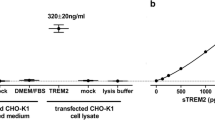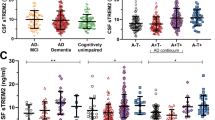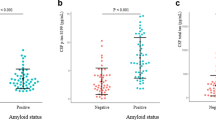Abstract
Background
Previous studies showed conflicting results regarding soluble triggering receptor expressed on myeloid cells 2 (sTREM2) level alteration in body fluid in Alzheimer’s disease (AD) and Parkinson’s disease (PD).
Methods
We applied the STATA 12.0 software to compute standard mean difference (SMD) and 95% confidence interval (CI).
Results
The study showed elevated sTREM2 level in cerebrospinal fluid (CSF) in AD, mild cognitive impairment (MCI), and preclinical AD (pre-AD) patients, compared to healthy controls (HCs) with random effects models (AD: SMD 0.28, 95% CI 0.12 to 0.44, I2 = 77.6%, p < 0.001; MCI: SMD 0.29, 95% CI 0.09 to 0.48, I2 = 89.7%, p < 0.001; pre-AD: SMD 0.24, 95% CI 0.00 to 0.48, I2 = 80.8%, p < 0.001). The study showed no significant difference in sTREM2 level in plasma between AD patients and HCs with a random effects model (SMD 0.06, 95% CI − 0.16 to 0.28, I2 = 65.6%, p = 0.008). The study showed no significant difference in sTREM2 level in CSF or plasma between PD patients and HCs with random effects models (CSF: SMD 0.33, 95% CI − 0.02 to 0.67, I2 = 85.6%, p < 0.001; plasma: SMD 0.37, 95% CI − 0.17 to 0.92, I2 = 77.8%, p = 0.011).
Conclusions
In conclusion, the study highlighted the CSF sTREM2 as a promising biomarker in the different clinical stages of AD. More studies were essential to explore the CSF and plasmatic concentrations of sTREM2 alteration in PD.







Similar content being viewed by others
Data availability
All data and materials in this manuscript are available via contacting the corresponding author on proper request.
References
Wang HY, Lin ZL, Yu XF, Bao Y, Cui XS, Kim NH (2016) Computational prediction of Alzheimer’s and Parkinson’s disease microRNAs in domestic animals. Asian-Australas J Anim Sci 29:782–792
Hardy J, Selkoe DJ (2002) The amyloid hypothesis of Alzheimer’s disease: progress and problems on the road to therapeutics. Science 297:353–356
Obeso JA, Rodriguez-Oroz MC, Goetz CG, Marin C, Kordower JH, Rodriguez M, Hirsch EC, Farrer M, Schapira AH, Halliday G (2010) Missing pieces in the Parkinson’s disease puzzle. Nat Med 16:653–661
Rhodes A, Evans LE, Alhazzani W, Levy MM, Antonelli M, Ferrer R, Kumar A, Sevransky JE, Sprung CL, Nunnally ME, Rochwerg B, Rubenfeld GD, Angus DC, Annane D, Beale RJ, Bellinghan GJ, Bernard GR, Chiche JD, Coopersmith C, De Backer DP, French CJ, Fujishima S, Gerlach H, Hidalgo JL, Hollenberg SM, Jones AE, Karnad DR, Kleinpell RM, Koh Y, Lisboa TC, Machado FR, Marini JJ, Marshall JC, Mazuski JE, McIntyre LA, McLean AS, Mehta S, Moreno RP, Myburgh J, Navalesi P, Nishida O, Osborn TM, Perner A, Plunkett CM, Ranieri M, Schorr CA, Seckel MA, Seymour CW, Shieh L, Shukri KA, Simpson SQ, Singer M, Thompson BT, Townsend SR, Van der Poll T, Vincent JL, Wiersinga WJ, Zimmerman JL, Dellinger RP (2017) Surviving sepsis campaign: international guidelines for management of sepsis and septic shock: 2016. Intensive Care Med 43:304–377
Cuyvers E, Bettens K, Philtjens S, Van Langenhove T, Gijselinck I, van der Zee J, Engelborghs S, Vandenbulcke M, Van Dongen J, Geerts N, Maes G, Mattheijssens M, Peeters K, Cras P, Vandenberghe R, De Deyn PP, Van Broeckhoven C, Cruts M, Sleegers K (2014) Investigating the role of rare heterozygous TREM2 variants in Alzheimer’s disease and frontotemporal dementia. Neurobiol Aging 35:726.e711-729
Guerreiro RJ, Lohmann E, Brás JM, Gibbs JR, Rohrer JD, Gurunlian N, Dursun B, Bilgic B, Hanagasi H, Gurvit H, Emre M, Singleton A, Hardy J (2013) Using exome sequencing to reveal mutations in TREM2 presenting as a frontotemporal dementia-like syndrome without bone involvement. JAMA Neurol 70:78–84
Numasawa Y, Yamaura C, Ishihara S, Shintani S, Yamazaki M, Tabunoki H, Satoh JI (2011) Nasu-Hakola disease with a splicing mutation of TREM2 in a Japanese family. Eur J Neurol 18:1179–1183
Heslegrave A, Heywood W, Paterson R, Magdalinou N, Svensson J, Johansson P, Öhrfelt A, Blennow K, Hardy J, Schott J, Mills K, Zetterberg H (2016) Increased cerebrospinal fluid soluble TREM2 concentration in Alzheimer’s disease. Mol Neurodegener 11:3
Ewers M, Franzmeier N, Suarez-Calvet M, Morenas-Rodriguez E, Caballero MAA, Kleinberger G, Piccio L, Cruchaga C, Deming Y, Dichgans M, Trojanowski JQ, Shaw LM, Weiner MW, Haass C, Alzheimers Dis Neuroimaging I (2019) Increased soluble TREM2 in cerebrospinal fluid is associated with reduced cognitive and clinical decline in Alzheimer’s disease. Sci Transl Med 11:507
Henjum K, Almdahl IS, Årskog V, Minthon L, Hansson O, Fladby T, Nilsson LN (2016) Cerebrospinal fluid soluble TREM2 in aging and Alzheimer’s disease. Alzheimers Res Ther 8:17
Peng G, Qiu J, Liu H, Zhou M, Huang S, Guo W, Lin Y, Chen X, Li Z, Li G, Zhang W, Zhang Y, Li X, Wu Z, Wei L, Yang X, Zhu X, Mo M, Xu P (2020) Analysis of cerebrospinal fluid soluble TREM2 and polymorphisms in sporadic Parkinson’s disease in a Chinese population 70(2):294–301
Qin Q, Wan H, Wang D, Li J, Qu Y, Zhao J, Li J, Xue Z (2022) The association of CSF sTREM2 with cognitive decline and its dynamic change in Parkinson’s disease: analysis of the PPMI cohort. Front Aging Neurosci 14:892493
Hu N, Tan MS, Yu JT, Sun L, Tan L, Wang YL, Jiang T, Tan L (2014) Increased expression of TREM2 in peripheral blood of Alzheimer’s disease patients. J Alzheimers Dis 38:497–501
Kleinberger G, Yamanishi Y, Suárez-Calvet M, Czirr E, Lohmann E, Cuyvers E, Struyfs H, Pettkus N, Wenninger-Weinzierl A, Mazaheri F, Tahirovic S, Lleó A, Alcolea D, Fortea J, Willem M, Lammich S, Molinuevo JL, Sánchez-Valle R, Antonell A, Ramirez A, Heneka MT, Sleegers K, van der Zee J, Martin JJ, Engelborghs S, Demirtas-Tatlidede A, Zetterberg H, Van Broeckhoven C, Gurvit H, Wyss-Coray T, Hardy J, Colonna M, Haass C (2014) TREM2 mutations implicated in neurodegeneration impair cell surface transport and phagocytosis. Sci Transl Med 6:243ra286
Gispert JD, Suárez-Calvet M, Monté GC, Tucholka A, Falcon C, Rojas S, Rami L, Sánchez-Valle R, Lladó A, Kleinberger G, Haass C, Molinuevo JL (2016) Cerebrospinal fluid sTREM2 levels are associated with gray matter volume increases and reduced diffusivity in early Alzheimer’s disease. Alzheimers Dement 12:1259–1272
Piccio L, Deming Y, Del-Águila JL, Ghezzi L, Holtzman DM, Fagan AM, Fenoglio C, Galimberti D, Borroni B, Cruchaga C (2016) Cerebrospinal fluid soluble TREM2 is higher in Alzheimer disease and associated with mutation status. Acta Neuropathol 131:925–933
Suárez-Calvet M, Kleinberger G, Araque Caballero M, Brendel M, Rominger A, Alcolea D, Fortea J, Lleó A, Blesa R, Gispert JD, Sánchez-Valle R, Antonell A, Rami L, Molinuevo JL, Brosseron F, Traschütz A, Heneka MT, Struyfs H, Engelborghs S, Sleegers K, Van Broeckhoven C, Zetterberg H, Nellgård B, Blennow K, Crispin A, Ewers M, Haass C (2016) sTREM2 cerebrospinal fluid levels are a potential biomarker for microglia activity in early-stage Alzheimer’s disease and associate with neuronal injury markers. EMBO Mol Med 8:466–476
Gispert JD, Monté GC, Suárez-Calvet M, Falcon C, Tucholka A, Rojas S, Rami L, Sánchez-Valle R, Lladó A, Kleinberger G, Haass C, Molinuevo JL (2017) The APOE ε4 genotype modulates CSF YKL-40 levels and their structural brain correlates in the continuum of Alzheimer’s disease but not those of sTREM2. Alzheimers Dement (Amst) 6:50–59
Bekris LM, Khrestian M, Dyne E, Shao Y, Pillai JA, Rao SM, Bemiller SM, Lamb B, Fernandez HH, Leverenz JB (2018) Soluble TREM2 and biomarkers of central and peripheral inflammation in neurodegenerative disease. J Neuroimmunol 319:19–27
Brosseron F, Traschütz A, Widmann CN, Kummer MP, Tacik P, Santarelli F, Jessen F, Heneka MT (2018) Characterization and clinical use of inflammatory cerebrospinal fluid protein markers in Alzheimer’s disease. Alzheimers Res Ther 10:25
Liu C, Yu J (2019) Genome-wide association studies for cerebrospinal fluid soluble TREM2 in Alzheimer’s disease. Front Aging Neurosci 11:297
Morenas-Rodriguez E, Alcolea D, Suarez-Calvet M, Munoz-Llahuna L, Vilaplana E, Sala I, Subirana A, Querol-Vilaseca M, Carmona-Iragui M, Illan-Gala I, Ribosa-Nogue R, Blesa R, Haass C, Fortea J, Lleo A (2019) Different pattern of CSF glial markers between dementia with Lewy bodies and Alzheimer’s disease. Sci Rep 9(1):7803
Suárez-Calvet M, Morenas-Rodríguez E, Kleinberger G, Schlepckow K, Araque Caballero M, Franzmeier N, Capell A, Fellerer K, Nuscher B, Eren E, Levin J, Deming Y, Piccio L, Karch CM, Cruchaga C, Shaw LM, Trojanowski JQ, Weiner M, Ewers M, Haass C (2019) Early increase of CSF sTREM2 in Alzheimer’s disease is associated with tau related-neurodegeneration but not with amyloid-β pathology. Mol Neurodegener 14:1
Banerjee G, Ambler G, Keshavan A, Paterson RW, Foiani MS, Toombs J, Heslegrave A, Dickson JC, Fraioli F, Groves AM, Lunn MP, Fox NC, Zetterberg H, Schott JM, Werring DJ (2020) Cerebrospinal fluid biomarkers in cerebral amyloid angiopathy. J Alzheimers Dis 74:1189–1201
Edwin TH, Henjum K, Nilsson LNG, Watne LO, Persson K, Eldholm RS, Saltvedt I, Halaas NB, Selbæk G, Engedal K, Strand BH, Knapskog AB (2020) A high cerebrospinal fluid soluble TREM2 level is associated with slow clinical progression of Alzheimer’s disease. Alzheimers Dement (Amst) 12:e12128
Ferri E, Rossi PD, Geraci A, Ciccone S, Cesari M, Arosio B (2020) The sTREM2 concentrations in the blood: a marker of neurodegeneration? Front Mol Biosci 7:627931
Franzmeier N, Suárez-Calvet M, Frontzkowski L, Moore A, Hohman TJ, Morenas-Rodriguez E, Nuscher B, Shaw L, Trojanowski JQ, Dichgans M, Kleinberger G, Haass C, Ewers M (2020) Higher CSF sTREM2 attenuates ApoE4-related risk for cognitive decline and neurodegeneration. Mol Neurodegener 15:57
Halaas NB, Henjum K, Blennow K, Dakhil S, Idland AV, Nilsson LN, Sederevicius D, Vidal-Piñeiro D, Walhovd KB, Wyller TB, Zetterberg H, Watne LO, Fjell AM (2020) CSF sTREM2 and Tau Work Together in Predicting Increased Temporal Lobe Atrophy in Older Adults. Cereb Cortex 30:2295–2306
Ma LZ, Tan L, Bi YL, Shen XN, Xu W, Ma YH, Li HQ, Dong Q, Yu JT (2020) Dynamic changes of CSF sTREM2 in preclinical Alzheimer’s disease: the CABLE study. Mol Neurodegener 15:25
Milà-Alomà M, Salvadó G, Gispert JD, Vilor-Tejedor N, Grau-Rivera O, Sala-Vila A, Sánchez-Benavides G, Arenaza-Urquijo EM, Crous-Bou M, González-de-Echávarri JM, Minguillon C, Fauria K, Simon M, Kollmorgen G, Zetterberg H, Blennow K, Suárez-Calvet M, Molinuevo JL (2020) Amyloid beta, tau, synaptic, neurodegeneration, and glial biomarkers in the preclinical stage of the Alzheimer’s continuum. Alzheimers Dement 16:1358–1371
Rauchmann BS, Sadlon A, Perneczky R (2020) Soluble TREM2 and inflammatory proteins in Alzheimer’s disease cerebrospinal fluid. J Alzheimers Dis 73:1615–1626
Wilson EN, Swarovski MS, Linortner P, Shahid M, Zuckerman AJ, Wang Q, Channappa D, Minhas PS, Mhatre SD, Plowey ED, Quinn JF, Zabetian CP, Tian L, Longo FM, Cholerton B, Montine TJ, Poston KL, Andreasson KI (2020) Soluble TREM2 is elevated in Parkinson’s disease subgroups with increased CSF tau. Brain 143:932–943
Bartl M, Dakna M, Galasko D, Hutten SJ, Foroud T, Quan M, Marek K, Siderowf A, Franz J, Trenkwalder C, Mollenhauer B (2021) Biomarkers of neurodegeneration and glial activation validated in Alzheimer’s disease assessed in longitudinal cerebrospinal fluid samples of Parkinson’s disease. PLoS One 16:e0257372
Diaz-Lucena D, Kruse N, Thune K, Schmitz M, Villar-Pique A, da Cunha JEG, Hermann P, Lopez-Perez O, Andres-Benito P, Ladogana A, Calero M, Vidal E, Riggert J, Pineau H, Sim V, Zetterberg H, Blennow K, del Rio JA, Marin-Moreno A, Espinosa JC, Torres JM, Sanchez-Valle R, Mollenhauer B, Ferrer I, Zerr I, Llorens F (2021) TREM2 expression in the brain and biological fluids in prion diseases. Acta Neuropathol 141:841–859
Ma LZ, Hu H, Wang ZT, Ou YN, Dong Q, Tan L, Yu JT (2021) P-tau and neurodegeneration mediate the effect of β-amyloid on cognition in non-demented elders. Alzheimers Res Ther 13:200
Mo M, Tang Y, Wei L, Qiu J, Peng G, Lin Y, Zhou M, Dai W, Zhang Z, Chen X, Liu H, Ding L, Ye P, Wu Y, Zhu X, Wu Z, Guo W, Xu P (2021) Soluble triggering receptor expressed on myeloid cells 2 from cerebrospinal fluid in sleep disorders related to Parkinson’s disease. Front Aging Neurosci 13:753210
Schulz I, Kruse N, Gera RG, Kremer T, Cedarbaum J, Barbour R, Zago W, Schade S (2021) Systematic assessment of 10 biomarker candidates focusing on α-synuclein-related disorders. Mov Disord 36(12):2874–2887
Van Hulle C, Jonaitis EM, Betthauser TJ, Batrla R, Wild N, Kollmorgen G, Andreasson U, Okonkwo O, Bendlin BB, Asthana S, Carlsson CM, Johnson SC, Zetterberg H, Blennow K (2021) An examination of a novel multipanel of CSF biomarkers in the Alzheimer’s disease clinical and pathological continuum. Alzheimers Dement 17:431–445
Chen YH, Lin RR, Huang HF, Xue YY, Tao QQ (2022) Microglial activation, tau pathology, and neurodegeneration biomarkers predict longitudinal cognitive decline in Alzheimer’s disease continuum. Front Aging Neurosci 14:848180
Winfree RL, Dumitrescu L, Blennow K, Zetterberg H, Gifford KA, Pechman KR, Jefferson AL, Hohman TJ (2022) Biological correlates of elevated soluble TREM2 in cerebrospinal fluid. Neurobiol Aging 118:88–98
Liu D, Cao B, Zhao Y, Huang H, McIntyre RS, Rosenblat JD, Zhou H (2018) Soluble TREM2 changes during the clinical course of Alzheimer’s disease: a meta-analysis. Neurosci Lett 686:10–16
Piccio L, Buonsanti C, Cella M, Tassi I, Schmidt RE, Fenoglio C, Rinker J 2nd, Naismith RT, Panina-Bordignon P, Passini N, Galimberti D, Scarpini E, Colonna M, Cross AH (2008) Identification of soluble TREM-2 in the cerebrospinal fluid and its association with multiple sclerosis and CNS inflammation. Brain 131:3081–3091
Jay TR, von Saucken VE, Landreth GE (2017) TREM2 in neurodegenerative diseases. Mol Neurodegener 12:56
Colonna M, Wang Y (2016) TREM2 variants: new keys to decipher Alzheimer disease pathogenesis. Nat Rev Neurosci 17:201–207
Yeh FL, Hansen DV, Sheng M (2017) TREM2, microglia, and neurodegenerative diseases. Trends Mol Med 23:512–533
Golde TE, Streit WJ, Chakrabarty P (2013) Alzheimer’s disease risk alleles in TREM2 illuminate innate immunity in Alzheimer’s disease. Alzheimers Res Ther 5:24
Wunderlich P, Glebov K, Kemmerling N, Tien NT, Neumann H, Walter J (2013) Sequential proteolytic processing of the triggering receptor expressed on myeloid cells-2 (TREM2) protein by ectodomain shedding and γ-secretase-dependent intramembranous cleavage. J Biol Chem 288:33027–33036
Yang J, Fu Z, Zhang X, Xiong M, Meng L, Zhang Z (2020) TREM2 ectodomain and its soluble form in Alzheimer’s disease. J Neuroinflammation 17:204
Guerreiro R, Wojtas A, Bras J, Carrasquillo M, Rogaeva E, Majounie E, Cruchaga C, Sassi C, Kauwe JS, Younkin S, Hazrati L, Collinge J, Pocock J, Lashley T, Williams J, Lambert JC, Amouyel P, Goate A, Rademakers R, Morgan K, Powell J, St George-Hyslop P, Singleton A, Hardy J (2013) TREM2 variants in Alzheimer’s disease. N Engl J Med 368:117–127
Harms MB, Neumann D, Benitez BA, Cooper B, Carrell D, Racette BA, Perlmutter JS, Goate A, Cruchaga C (2013) Parkinson disease is not associated with C9ORF72 repeat expansions. Neurobiol Aging 34:1519.e1511–1512
Ren M, Guo Y, Wei X, Yan S, Qin Y, Zhang X, Jiang F, Lou H (2018) TREM2 overexpression attenuates neuroinflammation and protects dopaminergic neurons in experimental models of Parkinson’s disease. Exp Neurol 302:205–213
Funding
This study was supported by the National Natural Science Foundation of China (no. 81901108).
Author information
Authors and Affiliations
Contributions
Lihua Gu contributed to the design of the study, plan the present study, and supervise the project. Lihua Gu and Hao Shu were in charge of article inclusion and had the major responsibility for analysis and manuscript writing. Yanjuan Wang was in charge of software use. All authors reviewed the manuscript.
Corresponding author
Ethics declarations
Competing interests
The authors declare no competing interests.
Ethics approval and consent to participate
Not applicable.
Consent for publication
All authors agree with the content and approve the publication of the manuscript.
Additional information
Publisher's note
Springer Nature remains neutral with regard to jurisdictional claims in published maps and institutional affiliations.
Supplementary Information
Below is the link to the electronic supplementary material.
Rights and permissions
Springer Nature or its licensor (e.g. a society or other partner) holds exclusive rights to this article under a publishing agreement with the author(s) or other rightsholder(s); author self-archiving of the accepted manuscript version of this article is solely governed by the terms of such publishing agreement and applicable law.
About this article
Cite this article
Gu, L., Shu, H. & Wang, Y. Soluble TREM2 in body fluid in Alzheimer’s disease and Parkinson’s disease. Neurol Sci 44, 2743–2751 (2023). https://doi.org/10.1007/s10072-023-06729-5
Received:
Accepted:
Published:
Issue Date:
DOI: https://doi.org/10.1007/s10072-023-06729-5




